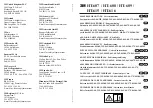
®
PS-3209
Wireless Light Sensor
7
013-15518A
Sensor Set-up
Orientation and Positioning
It is important to orient the sensor properly to receive
signals from satellites overhead, especially during initial
search mode (when the GPS status LED is blinking).
The antenna detects signals through the top side of the
sensor. The antenna is located above the rectangular
window that houses the temperature, pressure, and
humidity sensing elements. Hold the sensor with the top
side up and approximately horizontal and facing the sky.
Do no cover the antenna area.
Modes
The color of the GPS status LED indicates whether or
not the sensor is ready to make measurements. At initial
power on, the sensor enters “search mode”, in which it
searches the sky for available satellites. Initial search
mode typically lasts between 30 seconds and 2 minutes.
During “search mode”, the LED blinks red.
When the sensor is actively tracking three or more satel
-
lites, the LED blinks green.
If the Wireless GPS Sensor is turned off in the data col
-
lection software, or there is a hardware problem, the
GPS status LED does not shine.
If the sensor cannot track at least three satellites, it
enters GPS “lost mode”. In this mode it continues to
report its most recent position measurements. Use this
“stale” data with caution; it is incorrect if the sensor has
moved since its last valid measurement. In GPS lost
mode, the status LED blinks red and the sensor
searches for available satellites again.
Wireless Light Sensor
The Wireless Light Sensor measures illuminance (mea
-
sured in lux or lumen per square meter) and ultra-violet
index (UVI). For greatest accuracy, make sure that the
white disk on the top of the sensor is clean and dry.
Wireless Compass
The Wireless Compass measures magnetic heading in
degrees and radians.
Wind Direction (Magnetic)
When used with the PS-3553 Wireless Weather Acces
-
sories, the Wireless Compass gives wind direction.
Wind Direction (True)
The Wireless GPS Sensor’s coordinates combined with
the declination/variation for the sensor’s location pro
-
duces a calculated corrected/true wind direction.
Battery Life
Battery Usage
Battery life is very important to making the Wireless
Weather Sensor simple and always ready to use, so all
of the PASCO wireless products are designed for long
battery life. For example, the Weather Sensor turns itself
off after a brief time of inactivity to conserve battery life.
The battery life between charges for the Weather Sensor
ranges from two days to more than a week depending
on active sensors and sample rate.
If the battery status LED blinks red, connect the Weather
Source to the USB Charger or to a USB port.
Maximizing Battery Life
One of the factors that affects battery life is the storage
temperature. Therefore, avoid storing the Weather
Source in very cold or very hot environments.
If the battery will not hold a charge, contact PASCO
Technical Support.
Replacement Items
The Wireless Weather Sensor with GPS wind turbine
can be replaced with the PS-9879 Impeller Replace
-
ment-Anemometer. Check with Technical Support
regarding possible replacement items.

























